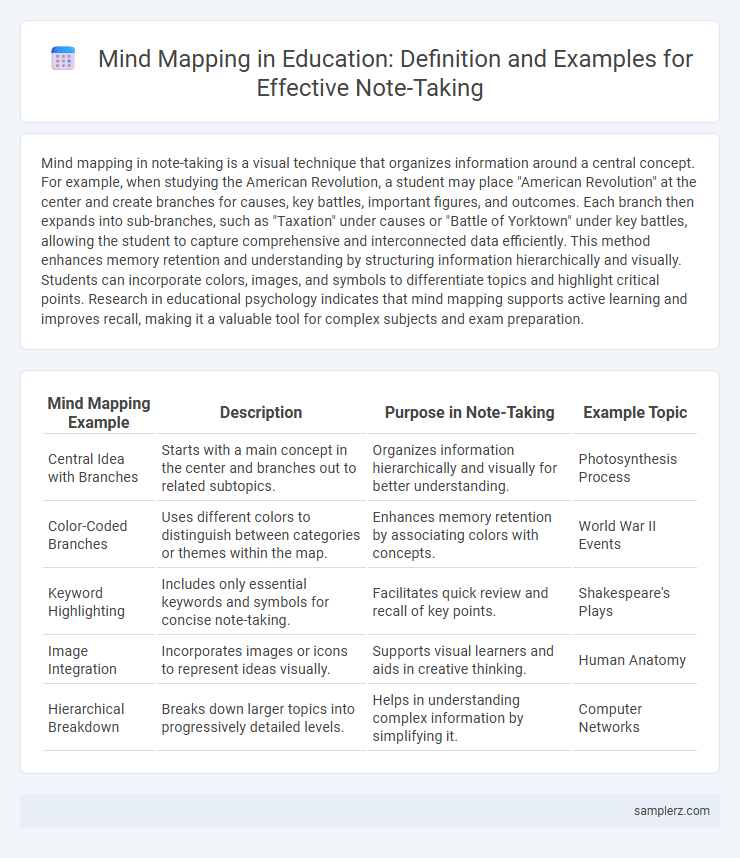Mind mapping in note-taking is a visual technique that organizes information around a central concept. For example, when studying the American Revolution, a student may place "American Revolution" at the center and create branches for causes, key battles, important figures, and outcomes. Each branch then expands into sub-branches, such as "Taxation" under causes or "Battle of Yorktown" under key battles, allowing the student to capture comprehensive and interconnected data efficiently. This method enhances memory retention and understanding by structuring information hierarchically and visually. Students can incorporate colors, images, and symbols to differentiate topics and highlight critical points. Research in educational psychology indicates that mind mapping supports active learning and improves recall, making it a valuable tool for complex subjects and exam preparation.
Table of Comparison
| Mind Mapping Example | Description | Purpose in Note-Taking | Example Topic |
|---|---|---|---|
| Central Idea with Branches | Starts with a main concept in the center and branches out to related subtopics. | Organizes information hierarchically and visually for better understanding. | Photosynthesis Process |
| Color-Coded Branches | Uses different colors to distinguish between categories or themes within the map. | Enhances memory retention by associating colors with concepts. | World War II Events |
| Keyword Highlighting | Includes only essential keywords and symbols for concise note-taking. | Facilitates quick review and recall of key points. | Shakespeare's Plays |
| Image Integration | Incorporates images or icons to represent ideas visually. | Supports visual learners and aids in creative thinking. | Human Anatomy |
| Hierarchical Breakdown | Breaks down larger topics into progressively detailed levels. | Helps in understanding complex information by simplifying it. | Computer Networks |
Introduction to Mind Mapping in Note-Taking
Mind mapping in note-taking enhances information retention by visually organizing concepts around a central idea, such as a chapter topic or lecture theme. Students create branches representing key points, subtopics, and related details, facilitating a clear overview of complex material. This method promotes active learning and improves recall by engaging both hemispheres of the brain through associations and imagery.
Key Benefits of Mind Mapping for Students
Mind mapping enhances students' note-taking by visually organizing information, which improves memory retention and comprehension. This technique stimulates creativity and critical thinking, enabling students to connect concepts and identify relationships effortlessly. Studies show that mind mapping increases study efficiency and reduces cognitive load, leading to better academic performance.
Basic Steps to Create a Mind Map for Lectures
Start by writing the lecture's main topic in the center of the page to serve as the core element of the mind map. Branch out with key concepts or ideas related to the topic, using keywords or short phrases to keep notes concise. Connect sub-branches with specific details, examples, or definitions to organize information hierarchically and visually during the note-taking process.
Mind Mapping Examples for Science Subjects
Mind mapping in science subjects enhances comprehension by visually organizing complex concepts such as the water cycle, cellular structure, and chemical reactions. For example, a mind map of the water cycle can include branches for evaporation, condensation, precipitation, and collection, illustrating their interconnections. This technique promotes active learning and retention by linking scientific terminology and processes in a clear, hierarchical structure.
Mind Map Note-Taking for Literature and Humanities
Mind Map Note-Taking in literature and humanities enhances comprehension by visually organizing themes, character relationships, and historical contexts, aiding memory retention. For example, a mind map on Shakespeare's "Macbeth" can branch into main characters, plot points, motifs like ambition and fate, and relevant historical background. This method fosters critical analysis and connects complex ideas effectively, making it an indispensable tool for students in these fields.
Using Digital Tools for Mind Mapping in Class
Using digital tools for mind mapping in class enhances note-taking by visually organizing complex ideas and improving information retention. Applications like MindMeister and XMind allow students to create interactive, customizable maps that link concepts with multimedia elements, fostering deeper understanding. These tools support collaborative learning environments, enabling real-time updates and shared insights among peers.
Visualizing Historical Events with Mind Maps
Visualizing historical events with mind maps enhances comprehension by organizing complex timelines and relationships into clear, interconnected nodes. Students can map out key figures, dates, causes, and effects, creating a visual representation that aids memory retention and critical analysis. This method transforms linear notes into dynamic diagrams, making the study of history more engaging and accessible.
Mind Mapping Techniques for Language Learning
Mind mapping techniques for language learning enhance vocabulary retention by visually connecting words and their meanings. Creating branches for grammar rules, pronunciation tips, and example sentences helps structure complex information effectively. Utilizing colorful nodes and images in mind maps supports memory recall and encourages active engagement during note-taking.
Collaborative Mind Mapping in Group Studies
Collaborative mind mapping in group studies enhances collective understanding by visually organizing ideas and fostering real-time brainstorming among students. Platforms like MindMeister and Miro allow multiple users to simultaneously contribute, edit, and link concepts, promoting active participation and knowledge sharing. This interactive approach improves retention, critical thinking, and team communication skills within educational settings.
Tips to Enhance Memory Retention with Mind Maps
Mind mapping enhances memory retention by visually organizing information into connected nodes, making complex concepts easier to recall. Using color-coded branches and keywords stimulates multiple areas of the brain, reinforcing learning pathways and aiding long-term memory. Incorporating images and concise phrases within mind maps further supports quick retrieval and deeper understanding of educational material.

example of mind mapping in note-taking Infographic
 samplerz.com
samplerz.com